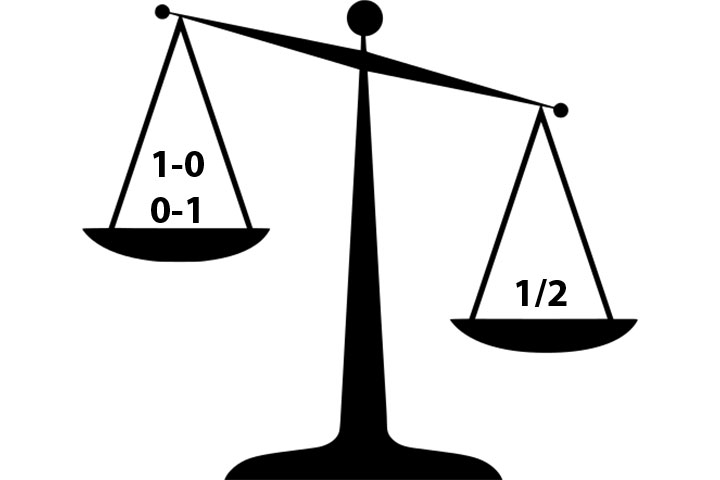An improved Armageddon?
The Norway Chess tournament is finally over, so it is a good time to analyze the conclusions that we can extract from the “Armageddon” experiment. First, we must praise the organizers for achieving this wonderful show, and commensurate audience records.
Draws: A real problem
The first aspect that grabs our attention is that the percentage of draws in the Norway Chess has been increasing year after year, apart from 2015, and in this edition, draws have beaten all records. Three out of four games ended up in a draw.
Norway Chess
| Year |
1-0 |
Draws |
0-1 |
Games |
Draw % |
| 2019 |
7 |
34 |
4 |
45 |
76% |
| 2018 |
8 |
28 |
3 |
39* |
72% |
| 2017 |
10 |
31 |
4 |
45 |
69% |
| 2016 |
12 |
30 |
3 |
45 |
67% |
| 2015 |
15 |
25 |
5 |
45 |
56% |
| 2014 |
10 |
28 |
7 |
45 |
62% |
| 2013 |
16 |
21 |
8 |
45 |
47% |
* Ding Liren retired after three rounds
A logical explanation for this fact is that the players that take part in the Norway Chess are world-class chess players and, as a consequence, they make very few mistakes. In addition, these players are facing constantly throughout the year, and they know each other very well.
When the field is mixed, the percentage of draws is lower, as it occurs in the Tata Steel tournament, for example:
Tata Steel Masters (Group A)
| Year |
1-0 |
Draws |
0-1 |
Games |
Draw % |
| 2019 |
20 |
54 |
17 |
91 |
59% |
| 2018 |
25 |
55 |
11 |
91 |
60% |
| 2017 |
23 |
57 |
11 |
91 |
63% |
| 2016 |
22 |
61 |
8 |
91 |
67% |
| 2015 |
28 |
45 |
18 |
91 |
49% |
| 2014 |
23 |
30 |
13 |
66 |
45% |
| 2013 |
28 |
50 |
13 |
91 |
55% |
And if we analyze tournaments with younger players or lower Elo ratings, this percentage of draws goes down, as we can see in Tata Steel Chess Challengers (Group B):
Tata Steel Chess Challengers (Group B)
| Year |
1-0 |
Draws |
0-1 |
Games |
Draw % |
| 2019 |
24 |
49 |
18 |
91 |
54% |
| 2018 |
18 |
55 |
18 |
91 |
60% |
| 2017 |
32 |
37 |
22 |
91 |
41% |
| 2016 |
28 |
36 |
27 |
91 |
40% |
| 2015 |
31 |
36 |
24 |
91 |
40% |
| 2014 |
35 |
35 |
21 |
91 |
38% |
| 2013 |
34 |
34 |
23 |
91 |
37% |
We understand now why there are so many draws in tournaments like Norway Chess, and a look to the past will confirm it. In the famous tournaments in Linares, back in the 80s and the 90s, the percentage of draws was much lower, between a 40% and a 50%. But when the number of players was reduced, and the level of the field increased, this percentage rose dramatically, reaching more than 70%. Once again, we had the same problem: all players were world-class and they knew each other too well.
The Sofia-Corsica rule, prohibiting draw offers before move 30, has improved this situation. However, there are still many short or boring games, especially when white plays in a very solid way.
A lot of draws will occur when the best players face each other. Thus, the idea of declaring a winner in each round using rapid chess makes a lot of sense, especially if we want chess to be more attractive to the general public. Here are my suggestions for improvement:
A winner every time
In each round a match winner shall be proclaimed. If the first game is a draw, another game will be played with the remaining time, and so on, until someone wins a game. The time spent on each move takes enormous value.
Colours balance
The player who is white in the first game will play black in the rest. In this way, the chances of each player are balanced, and short draws in the first game are discouraged.
Scoring
The winner in each round receives one point, the loser zero. Easy to understand for the public and the press.
Rating
For rating calculation each game is computed separately in the corresponding modality (classic, rapid or blitz), depending on the duration of the game.
Time control
 Each round has a maximum duration, which the organizers establish according to their convenience.
Each round has a maximum duration, which the organizers establish according to their convenience.
In all games, the players have 3 seconds per move, not cumulative, plus an initial time:
- For the first game each player has two and a half hours, or less, according to the attached table.
- For the second game, each player has the time not consumed in the first game, plus 15 or 30 minutes.
- For the rest of the games, the players will have only their remaining time.
The time of 3 seconds per move is not cumulative. If a player moves in 3 seconds or less, his clock remains stopped. After the first 3 seconds, it begins to consume the main time, until it is exhausted, in which case he loses on time. There is no need for the players to record the games, the electronic boards or the arbiters can do the job.
Each player has a time based on the maximum duration of the round, set by the organizer.
Round
max. duration |
Time each player receives |
... |
... |
... |
| |
1st game |
2nd game |
More games |
In all games |
| 7 hours |
150 minutes |
Remaining time + 30 min. |
Remaining time |
3 seconds per move |
| 6 hours |
120 minutes |
Remaining time + 30 min. |
Remaining time |
3 seconds per move |
| 5 hours |
120 minutes |
Remaining time + 15 min. |
Remaining time |
3 seconds per move |
| 4 hours |
90 minutes |
Remaining time + 15 min. |
Remaining time |
3 seconds per move |
| 3 hours |
60 minutes |
Remaining time + 15 min. |
Remaining time |
3 seconds per move |
The idea that we have seen in the Norway Chess is good, but I think it can be better. To give 1½ points to the winner of the Armageddon game makes things unnecessarily complicated, not to mention that we must explain that a draw is good for black in the second game, etcetera.
What do you think?


















 Each round has a maximum duration, which the organizers establish according to their convenience.
Each round has a maximum duration, which the organizers establish according to their convenience. 




